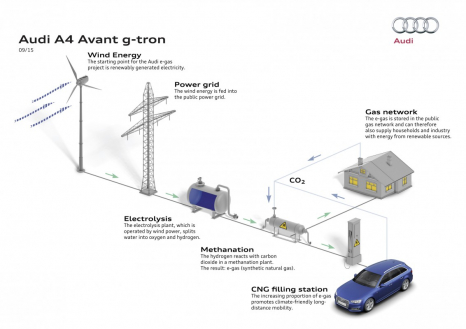Audi A4 Avant g-tron
The Audi A4 Avant g-tron* is the second model after the A3 Sportback g-tron* that customers can run on compressed natural gas (CNG) or Audi e-gas. Its 2.0 TFSI engines has an output of 125 kW (170 hp) and torque of 270 Nm (199.1 lb-ft).
The tanks for the Avant g-tron, which will become available in late 2016, are located under the rear of the car. They can hold 19 kilograms (41.9 lb) of gas at a pressure of 200 bar and are particularly light thanks to their novel layout. The inner layer consists of a matrix of gas-proof polyamide, while a second layer of mixed carbon-fiber-reinforced plastic (CFRP) and glass-fiber-reinforced plastic (GFRP) ensures extremely high strength. The third layer made of glass fiber helps visualize any external influences. Epoxy resin is used to bind the fiber materials.
Gas consumption of less than four kilograms per 100 kilometers (8.8 lb per 62.1 miles) in a normal driving cycle means extremely low fuel costs for the customer. With NEDC fuel consumption, the bivalent g-tron model drives over 500 kilometers (310.7 mi) on natural gas. When the gas left in the tank is less than about 0.6 of a kilogram (1.3 lb), gas pressure, falls below ten bar and the engine management automatically switches over to gasoline operation. This allows an additional range of 450 kilometers (279.6 mi).
The A4 Avant g-tron is particularly ecofriendly when it runs on Audi e‑gas. With this fuel, the company presents the first form of completely CO2-neutral long-distance mobility.** Audi produces this fuel with the help of renewable energy, water and CO2 in several power-to-gas plants.** Using this method, the brand with the Four Rings makes surpluses of renewable energy storable. The e-gas can be bought with a special filling-station card, which acts as a compensation instrument.
In parallel, Audi is continuing its research in the area of e-fuels. Together with its partners, the company has now developed a new method of producing e-gas. This secures the future supply for the rising number of g-tron models on the roads. Thanks to the new method, Audi e-gas is produced with the help of microorganisms by means of biological methanation. Compared with the previous used chemical process, the gas is produced at significantly lower ambient pressures and lower temperatures.
**Figures depend on the tires/wheels used.
Status: 9/2015
